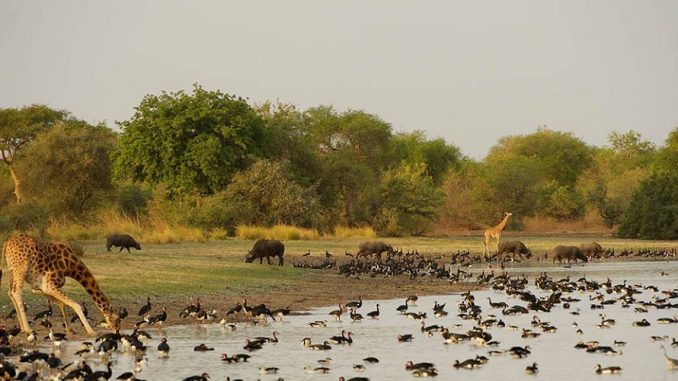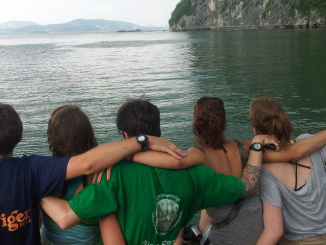
Let’s start at the start, and make this clear. The Foreign and Commonwealth Office does not really like the idea of you going to Chad. Its security map of the country is entirely coloured in red (“advise against all travel”) and yellow (“advise against all but essential travel”).
But as on-ground experts in Africa, we welcome to you Chad with open arms. Chad is safe and welcoming. Chad is the world’s 21st biggest country (496,000 square miles), so there’s a fair bit of it.
The Sahara Desert, which spreads across the north of the country, needs little introduction as an expanse of dust and dramatic desolation. The Sudanian Savanna, which dominates the south, requires more explanation – it’s a broad belt of tropical grassland which spans the whole continent, from Nigeria’s Atlantic coast in the west to the Ethiopian Highlands in the east. The semi-arid Sahel belt provides the meat to this sandwich, ebbing across Chad’s central torso. The capital N’Djamena sits roughly at the point where the Sahel and the Savanna meet.
Chad is one of the lesser-known countries that is completely landlocked in Central Africa. It is the fifth largest country in the continent as far as the area is concerned.
The Lake Chad is the largest water body in the country. Chad is a country with a lot to see and do and extreme national poverty. The total population of the country is only 15 million whereas N’Djamena is its largest and capital city.
Crude Oil trading and cotton industry are the country’s primary source of export earnings. Having a huge number of impressive natural treasures which are really challenging to explore but reward intrepid travelers with magnificent adventures.
Here are 11 Reasons to Visit and Tourist Attractions in Chad
- Lake Chad
One reason is Lake Chad, the vast body of water which is not always vast (it has been known to shrink and grow according to weather conditions). Confusing? Perhaps. Located on the country’s western borders, Lake Chad used to be the world’s largest freshwater lake in its heyday that was some 35 years ago. It is of huge economic and historical importance as it provides water to nearly 75 million people belonging to 4 different countries that surround it. Drastic climate changes and severe droughts have shrunk the lake to a fraction of its former size and grandeur. However, it still remains a popular spot for fishing, boating, and other marine activities.

Lake Chad spills over the borders into Cameroon, Niger and Nigeria, making it a multinational proposition –Its soul is provided by the River Chari, which begins in the highlands of the Central African Republic, and flows north-west across Chad, before pouring into the lake.
- Tibesti Mountains
Head to the far north of Chad, and you find a place where the Sahara Desert reaches for the heavens. This is the Tibesti Mountains – which sprawl across the border into Libya, but save their song-and-dance moment for Chad in the form of Emi Koussi, a shield volcano that rears to 3,445m. These numbers make it the Sahara’s rooftop.
Tibesti Mountains is a mountainous range situated in the domain of the Toubou people in the extreme north of Chad. It is quite difficult to reach and explore this region but it does have unorthodox rewards for adventure and thrill-seeking travelers. The place boasts a large number of canyons, massive gravels, humungous peaks and forested spots. Hiking and mountaineering are popular activities in the region. Tourists to this place can also enjoy camel race-viewing, examining the parietal art and visiting hot thermal springs.
- Ennedi Region
Away in the east of the country, towards the border with Sudan (Located in the middle of Sahara Desert is the Ennedi Region: a harsh landscape home to some of the most remarkable and unusual rock formations in the world). The Ennedi Plateau is another Chadian geological wonder. An expanse of hard sandstone assailed on all sides by the Sahara, it rises to 4,760ft (1,450m).
The flat trajectory is dominated by jagged canyons and stone arches that wind up like natural works of art. Prehistoric cave paintings depict the times when primeval caravans trespassed through this region. Ennedi is also famous amongst hikers as it is an extremely difficult place to survive in without proficient provisions.
Its landscape sculpted into rugged spires, pillars and columns of rock that are not wholly dissimilar to the monoliths more famously found far across the Atlantic in Utah. Unlike Utah, it is also home to the desert crocodile.
- Zakouma National Park
Lying in the southeastern part of the country, Zakouma National Park is a prime location for safari and is one of the last central refuges for wildlife in Africa. Although Chad is rarely promoted as a safari destination, the Park is brimming with rare species of mammals and birds and accommodation services are provided in form of camping grounds that provide the best game viewing area. Numerous restaurants and a hotel have also been developed within the park.
- It’s landlocked – but you can go to the beach
Chad does not flirt with the ocean. It is not even close to the ocean. The nearest seaport, Douala in Cameroon, is some 660 miles to the south-west. But if you feel like a stroll on the sand, you can have it in the capital N’Djamena, which has a long beach on the Chari.
- N’Djamena
N’Djamena is the capital and largest city in Chad and almost depicts two different cities in one. It boasts a beautiful blend of contemporary and prehistoric cultural norms. The western part of the city is dominated by colonial architecture and commercial premises surrounded by green-lidded oasis. The eastern part contains the native localities cramped by narrow alleyways. Near the center, Mosque is the Grand Market which is one of the city’s oldest districts and offers pretty much everything for consumers.
- Chad National Museum
Musée National N’Djamena is the national museum of Chad located in the capital city of N’Djamena. The complex was established in late 1962 and transferred to a whole different location. It had four fundamental exhibits ranging from prehistory, protohistory, archives and folk arts/traditions. The artifacts and medieval items include stone heads, implements and helve-holed axes from ancient ages. Raw items discovered from traditional sanctuaries such as human masks and bone tools are also displayed.
This is home to a skull of a sahelanthropus, a distant precursor to humanity that lived in the region seven million years ago. It is nicknamed “Toumai” (“Hope of Life” in the local Daza language).
- Lakes of Ounianga
Chad’s sole World Heritage Site, the Lakes of Ounianga is a series of 18 lakes in Sahara. The total area spanned by the lakes is around 20 square kilometers. They are located in a hot desert and are supplied by underground fossil water. The names of the lakes are copied from a nearby native village called Ounianga. Waters are usually saline due to high rates of evaporation and the lakes have pretty low current levels as they receive only 2mm rainfall per year.

- Douguia’s Chari River
Chari River flows from the Central African Republic into the Lake Chad and joined by its principal tributaries. The city of Douguia receives much of its tourist audience because of Chari River which is a popular hotspot. The river supports an important sector in fishing industry and amongst the famous marine activities is taking a boat trip in a traditional canoe along the Chari River. It leads to sightings of beautiful flocks of bird and fabulous photographic opportunities around the African shores.
- Guelta d’Archei
Guelta d’Archei is the most renowned canyon in the Sahara desert. It is situated in the Ennedi Plateau near the town of Fada. The panoramic scenery offered by its tallest spot is absolutely fantabulous and embedded artworks on ancient walls provide a medieval feel to the region. The region is dominated by several kinds of animals, most notably the Nile crocodiles. The place is barren and the terrain is totally flat and it required a maximal workload to actually reach this area.
- Abeche
Abeche is a cultural and an ethnographic center of Chad and is the fourth largest city in the country. The city boasts remnants of ancient fortresses, structures, and tombs of former sultans that ruled Chad in previous ages. The city is an important cattle-raising complex and has major roads connecting it to N’djamena as well as to Sudan and Abeche Airport. It has been a stronghold for the French for a large number of years and was used as a trade route for Arabian slaves. Abeche’s markets, mosques, churches and French-era buildings are tourist spots at present.
Bonus: Volunteer in Chad:
As far as Chad volunteer travel opportunities are concerned you’ll have to decide just what you’re into. Go Volunteer Africa places volunteers with a number of volunteer programs in Chad that provide economic support, education, capacity building for rural, semi-urban people and healthcare support across Chad. Each volunteer placement in Chad provides a totally different experience, but main activities involve working with local children, wildlife conservation, environment conservation, youth and economic empowerment.
TRAVEL INSURANCE:
You’ll need to buy appropriate travel insurance covering your participation on the program. You won’t be able to go without the right travel insurance so double check to avoid disappointment. Please make sure that you’re covered for the whole duration of your trip – from the day you leave your home to the day you return. Buy here Now
Get Started
Make an inquiry here




